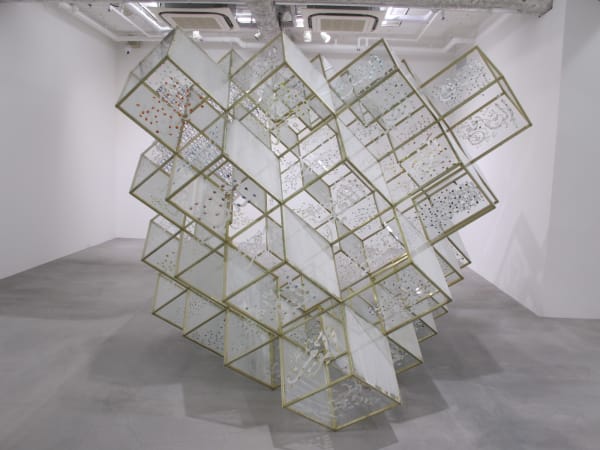ROPPONGI MOSQUE: Masanori Handa
Taking sceneries or incidents that the artist encounters as momentum, Masanori Handa opens his senses and visualizes the fluid and sometime-utterly incoherent world. In this exhibition, Handa rebuilds the"150 hedron" which he found at the mosque in Ebina in the past. The artist explored this silhouette in Europe and collected the materials in Andalusia. The ceiling-high structure appears in the centre of corridor-styled installation.
"150 hedron", which is the main work of this exhibition, is a kind of symbolic object in Islam that is under recognized even by Muslims. It usually has 99 dignified names on each faces. He describes about a number of cities inter-dispersed within the Islamic region and their cycle of daily life in Islamic faith as "indescribable large framework of many layers" and "nothing can ever be fully explained including incidents within this universe or understood by human beings". The artist builds up this "150 hedron" here as a globe, a world map which goes beyond the Islamic world. Along with several other objects, the artist entitles the installation "ROPPONGI MOSQUE" which is consisted of brass structure, tiles and glass colored with butter milk.
Born in Kanagawa in 1979, the artist completed a BA in Fine Arts at the Tokyo University of the Arts in 2003. He has been participated in various exhibitions including Echigo-Tsumari Triennale in 2006 and the "The Age of Micropop" at Art Tower Mito in 2007. "Study", shown within the installation work covering the entire interior wall surface of the gallery using with architectural siding board, was exhibited in 2010. These were other examples of the artist's installations of massive scale and volume.
In 2008, he shared the studio in Berlin with Rebecca Horn for just under a year as part of "The Rolex Mentor and Protégé Art Programme". In 2010, he received a grant from the Agency for Cultural Affairs. He has been based in Germany since that time.
His related new installation work will be exhibited in the group exhibition, "Ways of Worldmaking" at the National Museum of Art, Osaka from 4th October.






